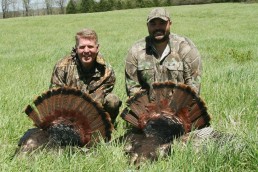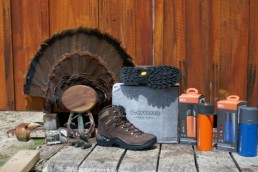Bag that Bird with a Blind this Spring
SHARE THIS POST
Spring turkey hunting is here, and the excitement that builds up as the game gets into swing—calling to birds and getting them to call back to you—is like no other experience in the woods. A variety of methods and equipment options are used to take turkeys, but often it’s a relatively simple procedure. Hunters suit up head to toe in high-quality camouflage, grab their shotguns and call, sit down in the woods somewhere and start talking to the gobblers.
Sometimes you have to move around to get closer to a bird that responds but won’t move. Other times, you can stay put and draw him in for a shot. When gobblers get tough, such as in an area with a lot of hunting pressure, other tactics can sometimes be needed. One method we’ve utilized to take some massive birds has been to get out into a field with a blind.
The curveball
When you just can’t get near a bird in the woods you can sometimes nail them as they’re crossing a field or feeding in it. If you know routes where turkeys normally travel it can be easier, but fields along travel routes from one patch of woods to another, or fields that turkeys feed in with regularity like those where crops are planted or places with planted game food plots, are all great locations to set up. The only problem with hunting turkeys in a field is the complete lack of cover. Normally, our camouflage clothing is all we need in the woods. In a field, though, there’s nothing to blend in with and your silhouette so you can often be spotted by these birds, even when in a low position. But turkeys will readily walk up on a blind where you can make an easy shot.
Are you enjoying this post?
You can be among the first to get the latest info on where to go, what to use and how to use it!
In truth, I’ve never been a big fan of blinds in most situations, especially when hunting deer. I’ve seen deer walk around a blind, spooked and just stare at it the entire time. They often stay back in the woods farther away through the trees and brush, places where you can’t get a clean shot. So, you need to set up the blind for a few weeks before you are actually hunting out of it, even if you are on private land. Another option is to “brush” a blind in where you perform your setup putting a blind up next to a big tree or some brush or put it in the middle of a patch of tall, thick grass with trees or limbs nearby and pile logs and brush up around it.
Silhouette
When it comes to turkeys, backing a blind up against wood or brushing it in is just not always necessary. And, we’ve killed a number of trophy-caliber birds out of a blind we’ve set up just an hour or so earlier far out in a field where turkeys cross or feed. Turkeys just aren’t wary of new things like deer are, and won’t typically spook around a newer object in the way that whitetails do. While turkeys have excellent eyesight, the vision of a deer pales in comparison. Because deer can’t see as well they’re more likely to be afraid of anything in their world that appears different, especially since they can’t get a look at it from a farther distance like toms can. Turkeys can see tiny details at significant ranges, so as long as they don’t spot movement, that blind isn’t going to throw up any alarm bells and they will go about their business of feeding in a field or crossing one to move from one area to the next without hesitating.
Get out there
The next time turkeys are giving you a tough time, grab your blind and try moving out of the woods and into a field they use; it can pay big dividends and make a season. The woods call to us as the lovers of God’s great outdoors. Spending time hunting, fishing, biking or hiking is like medicine to us all, so get out there.
Did you enjoy this post?
You can be among the first to get the latest info on where to go, what to use and how to use it!
Colby Simms
Colby Simms is a professional fisherman, media personality, guide and owner of Colby Simms Outdoors Group. He runs a guide service booking guided fishing and hunting trips, and sells tackle. Contact him at colbysimmsoutdoors@hotmail.com, Facebook @ColbySimmsOutdoors and @ColbySimmsSportFishingPro, or 618-521-0526 or 573-358-5948.

